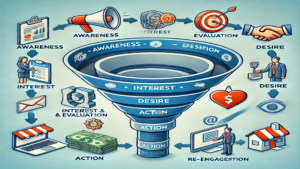
As a Businessperson, attracting the attention of leads and prospects is an ongoing challenge.
The more difficult it is to sell, the more demanding the role becomes.
A sales funnel offers a structured, relationship-focused approach, preventing the sales pitch from being overly aggressive.
Instead of directly pushing products or services, a sales funnel educates potential customers, enabling them to make informed purchasing decisions.
Although the stages of the sales funnel may vary, they generally follow a consistent flow: awareness, interest and evaluation, desire, action, and re-engagement.
At each stage of the funnel, it’s crucial to provide the right information, content, or answers that move prospects closer to making a purchase.
Research and Preparation
While not an official part of the sales funnel, research and preparation are essential for future success.
Start by defining the brand values, as understanding the company’s foundation will help build long-term customer relationships.
The target customers beyond just their potential to generate revenue.
Creating buyer personas can clarify who the ideal customer is, what challenges they face, and how the offerings can address those challenges.
Buyer personas also guide what type of content is needed at each funnel stage.
By understanding the prospects’ goals, frustrations, and personalities, one can better tailor the communication.
Awareness
The first stage of the funnel is awareness, where the primary goal is to increase brand visibility and collect leads.
It’s important to target the right audience without pushing any specific products or services. Instead, focus on sharing ideas, solutions, and advice.
Effective ways to boost brand awareness include:
Sponsored social media posts
SEO
Guest blogging or podcasting
Ebooks and whitepapers
Independent research
Webinars
Videos
Infographics
In-person events
Content at this stage should be informative, engaging, and fun.
Use buyer personas to identify where the audience spends their time online, such as their preferred social media platforms, and target those areas.
Non-traditional platforms like dating apps or video games could also be an option, depending on the brand personality.
Ensure that the content encourages a next step, such as signing up for a newsletter or registering for a webinar. Track tangible conversions like social media follows or email signups and evaluate how the audience engages versus how many convert.
If conversion rates are low, adjust the content or explore better distribution channels.
Interest and Evaluation
Once a lead progresses from the awareness stage, they enter the interest and evaluation phase.
Here, the focus shifts to building a relationship and understanding their specific goals.
Maintain a consistent brand voice and message that resonates with the target audience.
This message should be communicated through various content channels, including:
Email campaigns
Blog posts
Lead magnets
Chatbots
Social media
Free trials
Retargeting campaigns
Monitor which content resonates with leads by tracking clicks on emails or social media engagements.
This will give insights into their problems and what solutions they are seeking.
Be proactive in following up on any inquiries they may have, even if they’re not yet ready to buy.
Establishing helpful connections increases the likelihood they’ll return when they’re ready to make a purchase.
Use retargeting to re-engage visitors who didn’t convert on their first visit through ads on platforms like Facebook or Google.
Desire
At the desire stage, the goal is to make the lead seriously consider purchasing.
Popular content types at this stage include:
Testimonials
Pricing pages
Case studies
Discount codes
Customer reviews and product recommendations
Live demonstrations or webinars
Product comparisons
The objective is to show prospects what life would be like as a customer, emphasizing the return on investment. Make the buying process as simple and compelling as possible.
Action
This is where the lead takes action—making a purchase. After nurturing the lead, be ready to close the deal and provide support to ensure they succeed with the product or service.
Content at this stage might include:
Customer success tips
Special offers
Product implementation or training webinars
Bundle packages
Follow-up email campaigns
Timely follow-up is critical. If customers feel unsupported after their purchase, they may hesitate to buy again, particularly with subscription-based models that depend on repeat buyers.
Re-engagement
Loyal customers can be invaluable for a brand.
Even a 5% increase in retention can boost profits by 25-95%.
Re-engaging customers who’ve had a positive experience can lead to additional purchases and new referrals.
Effective re-engagement strategies include:
Referral programs
Upsell campaigns
Re-engagement email campaigns
Product-specific webinars and tutorials
Live events
Continue offering valuable content and promotions that interest customers, even after they’ve made a purchase.
At this stage, focus on maintaining a long-term relationship by introducing new features or encouraging brand ambassadorship.
Measure re-engagement by tracking the lifetime value of customers, assessing how long they’ve been with the brand and how much they’ve spent.
This helps determine if the product or service is consistently meeting the needs of the most loyal customers.
The sales funnel is an essential tool for targeting the audience effectively.
By understanding how the audience thinks and moves through the buying process, and by providing tailored content at each stage, significantly improve conversion rates and foster lasting customer relationships.
